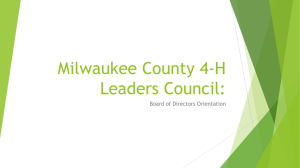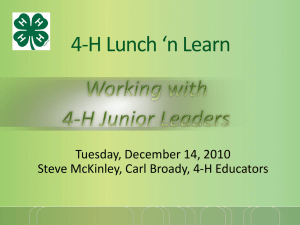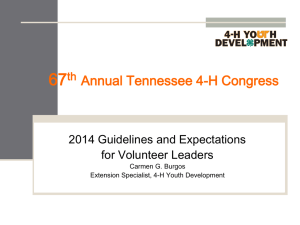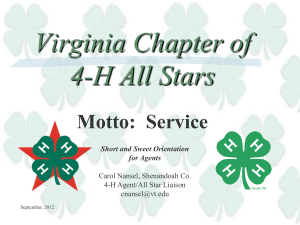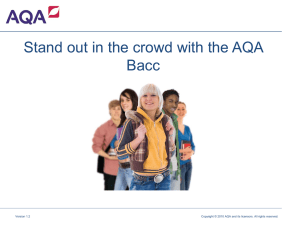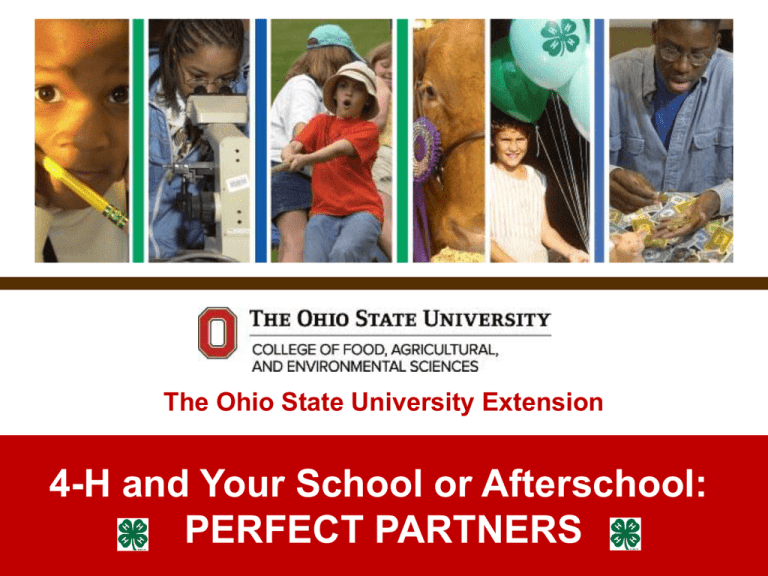
The Ohio State University Extension
4-H and Your School or Afterschool:
PERFECT PARTNERS
WHAT IS 4-H?
• Founded in 1902 in Springfield, Ohio
• Nation’s largest youth development program
• 6.5 million youth from urban, suburban & rural
areas participate in 4-H
• 540,000 volunteers nationwide
• 60 million alumni
• One in every six Ohioans
• Managed by the state
land-grant university (OSU)
WHERE DO I FIND 4-H IN OHIO?
4-H is a part of The Ohio
State University through OSU
Extension. For additional
information log on to:
www.ohio4h.org
www.extension.osu.edu
http://franklin.osu.edu
http://www.youtube.com/user/OSUExtension
Former OSU
President E.
Gordon Gee
was in 4-H
Diversity Statement
Ohio State University Extension embraces human diversity and
is committed to ensuring that all research and related
educational programs are available to clientele on a
nondiscriminatory basis without regard to race, color, religion,
sex, age, national origin, sexual orientation, gender identity or
expression, disability, or veteran status. This statement is in
accordance with United States Civil Rights Laws and the USDA.
Keith L. Smith, Associate Vice President for Agricultural
Administration; Associate Dean, College of Food, Agricultural,
and Environmental Sciences; Director, Ohio State University
Extension and Gist Chair in Extension Education and
Leadership. TDD No. 800-589-8292 (Ohio only) or 614-2926181.
National 4-H Center
4-H Emblem
WHAT DO THE H’S MEAN?
• Head—
Managing,
Thinking
• Heart—
Relating,
Caring
• Hands—
Giving,
Working
• Health—
Being, Living
LEARNING EXPERIENCES
Three types of learning experiences:
1.Hands-on (making, producing, practicing, observing,
etc.)
2.Organized activities (field trips, demonstrations,
workshops, camps, etc.)
3.Leadership/Citizenship (conducting, planning,
assisting, informing, organizing, etc.)
LIFE SKILLS MODEL
Source: Patricia Hendricks, “Targeting Life Skills Model: Incorporating developmentally appropriate learning
opportunities to assess impact of life skill development (Rev. Ed.).Iowa State University, 4H-137A
EIGHT IMPACTS OF 4-H:
1. Opportunity to value & practice service
2.
3.
4.
5.
6.
7.
8.
Self-determination
Positive relationships with caring adults
Emotionally & physically safe place
Inclusive environment
Engagement in learning
Opportunity for mastery
Ability to see oneself as active participant
Kansas State University, National Impact Project Steering Group, 2000
TEACH A MAN TO FISH…
“Experiential learning, or learning by doing, is
the most effective way of helping children
gain knowledge, since it engages learners
actively, encourages them to think and puzzle
things out for themselves, makes them work
harder, and ultimately helps them to learn
more.”
--A Sampler of 4-H Afterschool Activities,
C Penney Afterschool Fund
School Enrichment Definition
“Groups of youth receiving a sequence of
learning experiences in cooperation with
[after]school officials during [after]school
hours, to support the [after]school
curriculum.”
Source: National 4-H Center; located in Chevy Chase, Maryland, outside of Washington D.C., as quoted by Bob Horton in
4-H and Public Schools: Effective 4-H School Enrichment Programs.
WHY 4-H IN SCHOOL/AFTERSCHOOL?
• Inexpensive curriculum—a variety of fun
subjects available
• Meets content standards
• Encourages interactive learning
• Features hands-on project learning
• Helps develop leadership & life skills
4-H PROJECT CATEGORIES
•
•
•
•
•
•
•
•
•
•
STEM
Companion Animals
Veterinary Science
Food & Nutrition
Healthy Living
Money Management
Natural Resources
Creative & Leisure Arts
Leadership & Citizenship
Group Projects
CLOVERBUDS
Curriculum designed for youth who are age 5 and
are enrolled in Kindergarten as of January 1 of the
current 4-H year.
Leader Directed
Fun, Activity Based, Non-Competitive,
Success Oriented
Developmentally Appropriate
Focused on Group Centered Learning
Made Up of Many Types of Positive Activities
Cloverbud Camp, Friday, June 6, 2014
Cloverbud Website: http://cloverbudconnections.osu.edu
Starting a Non-Traditional 4-H Club
Potential Benefits for educators:
• Research-based curriculum
• Hands-on activities that can be applied
to real-life situations
• 4-H Personnel can provide programs,
information, support and advice
Source: Bob Horton, fact sheet, 4-H and Public Schools: Effective 4-H School Enrichment Programs
Starting a Non-Traditional 4-H Club
Your Responsibilities:
•
•
•
•
•
•
•
•
Contact Franklin County Extension
personnel
Obtain 4-H materials
Attend orientation trainings if offered
Complete forms on time
Complete a background check
Be committed to the 4-H program!
Honor copyrights
Complete a Memorandum of Understanding
Source: Bob Horton, fact sheet, 4-H and Public Schools: Effective 4-H School Enrichment Programs
What is a MOU?
“A Memorandum of Understanding
(MOU) is simply a written agreement to
identify the working relationships &
guidelines between collaborating or
partnering agencies”
Source: University of Florida Extension, “Creating memorandums of Understanding/Agreement with Affiliate
Organizations of 4-H”; Marilyn N. Norman and Joy C.Jordan
NEXT STEPS:
• Start small
• Choose curriculum you can afford and
support
• Embed curriculum into your main curriculum
• Get stakeholders on board
• Be organized
• Define mission within the 4-H guidelines
• Engage youth in program for buy in
Source: Bob Horton, fact sheet, 4-H and Public Schools: Effective 4-H School Enrichment Programs
Youth Bonuses:
• Opportunity to complete a project
• Individual efforts can be judged and
recognized with a 4-H ribbon onsite
(Speeches, Skits, Demonstrations)
• Youth can attend 4-H Camp in June
STARTING A TRADITIONAL
4-H CLUB
In 2014 the opportunity will exist to start a 4-H
Club in your school/afterschool program. Youth
can:
1. Hold weekly meetings
2. Complete a project & be judged at the
Franklin Co. Fair
3. Set up a 4-H Club Booth
4. Participate in 4-H Camp if desired
5. Adult personnel will become 4-H Advisors
STARTING A TRADITIONAL
4-H CLUB--Process
1. Necessary paperwork completed and on
file at Franklin County Office
2. EIN obtained from IRS
3. Tax exempt status on file
4. Constitution & by-laws drafted
5. Annual financial report submitted
6. Fingerprint background checks
7. Required training completed
SPECIAL PROGRAMS:
For a nominal fee a 4-H educator will come to
your location and do a special program
EcoBot Challenge
The EcoBot
Challenge is:
• Stem-based
• Educational
• Fun
ROCKETS AWAY!
CHICKQUEST
A chick hatching program with
incubators you can borrow.
REAL MONEY. REAL WORLD.
Involves a
simulation
Financial literacy
education
at it’s finest!
EDUCATOR WORKSHOPS
Project WET—Water Education for
Teachers
Build a Pizza Garden
Fishy Science
Scrapbooking the Standards
Growing a School Garden Conference
Second
Annual-May 2nd
TO BECOME INVOLVED:
If your program is in Franklin County contact:
Sue Hogan
Program Assistant, 4-H Youth Development
OSU Extension Franklin County
614-866-6900, extension 214
hogan.239@osu.edu
If your program is in another county in Ohio log on to:
www.ohio4h.org and click on “County Offices” to find
an Extension office near you. When you call, explain
that you would like to use 4-H curriculum/project books
in your program. Each individual county may have a
different policy/program for working with you.

